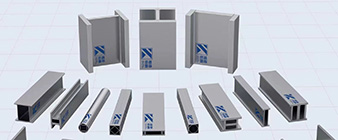2507 (UNS S32750) Superduplex stainless steel is an excellent choice for hollow structural sections (HSS) due to its exceptional combination of strength, corrosion resistance and structural properties. The following are the key features and benefits of 2507 Super Duplex Stainless Steel High Speed Steel:
Strength and Stiffness:
2507 Super Duplex Stainless Steel High Speed Steel has very high tensile and yield strengths, typically 800 to 1000 MPa and 550 to 700 MPa respectively.
The high strength-to-weight ratio of 2507 allows the design of lighter and more efficient high-speed steels than traditional carbon steel or other stainless steel options.
The superior strength of 2507 HSS allows the use of thinner wall thicknesses, resulting in less material usage and lower overall weight.
Corrosion resistance:
2507 super duplex stainless steel has excellent resistance to a variety of corrosive environments, including seawater, chlorides, acids and high temperature oxidation.
The high chromium (24-26%) and molybdenum (3-4%) content in 2507 provides excellent protection against pitting, crevice and stress corrosion cracking.
This exceptional corrosion resistance makes 2507 HSS ideal for applications in harsh, corrosive environments such as offshore, coastal and industrial environments.
Fatigue and Fracture Toughness:
2507 Super Duplex Stainless Steel HSS has excellent fatigue and fracture resistance, making it suitable for structural applications subject to cyclic loading or impact.
2507’s balanced austenite-ferrite microstructure and high strength contribute to its ability to withstand repeated stress and resist crack propagation.
Thermal and low temperature stability:
2507 super duplex stainless steel maintains its mechanical properties and corrosion resistance at both high and low temperatures.
This thermal stability and resistance to brittleness at low temperatures enables 2507 HSS to be used in applications with varying climate conditions, including liquefied natural gas (LNG) storage and transportation.
Solderability and Fabrication:
2507 superduplex stainless steel is easy to weld, but welding parameters require careful control of welding parameters to maintain the required ferrite-austenite balance and prevent harmful phases.
The high strength and ductility of 2507 make it suitable for a variety of manufacturing techniques, including rolling, bending and welding, to produce high-speed steel in a variety of cross-sectional shapes and sizes.
Offshore oil and gas platforms and subsea infrastructure
Chemical and Petrochemical Processing Equipment
Power generation components such as heat exchangers and turbines
Desalination and Water Treatment Plants
Cryogenic storage and transportation systems
The combination of high strength, excellent corrosion resistance and thermal stability makes 2507 superduplex stainless steel ideal for hollow structural profiles in applications requiring long-lasting, durable and low-maintenance structural components in challenging environments.
-
 2024-9-19 UNS S32570 VS 1.4410 stainless steel structural profile
2024-9-19 UNS S32570 VS 1.4410 stainless steel structural profile -
 2024-9-19 Alloy 718/2.4668/UNS N07718 Hollow structural profile applications
2024-9-19 Alloy 718/2.4668/UNS N07718 Hollow structural profile applications -
2024-9-27 What are the typical applications of 318LN (1.4462) duplex stainless steel structural profiles?
-
 2024-9-16 S32205 stainless steel of Introduction to the performance
2024-9-16 S32205 stainless steel of Introduction to the performance -
2024-1-10 Stainless Steel – Austenitic – 1.4404 (316L) Bar and structural Section
-
 2024-4-03 Advantages and applications of stainless steel hollow profiles
2024-4-03 Advantages and applications of stainless steel hollow profiles -
 2024-9-20 How does high-strength S690 steel play a role in the construction field?
2024-9-20 How does high-strength S690 steel play a role in the construction field?



